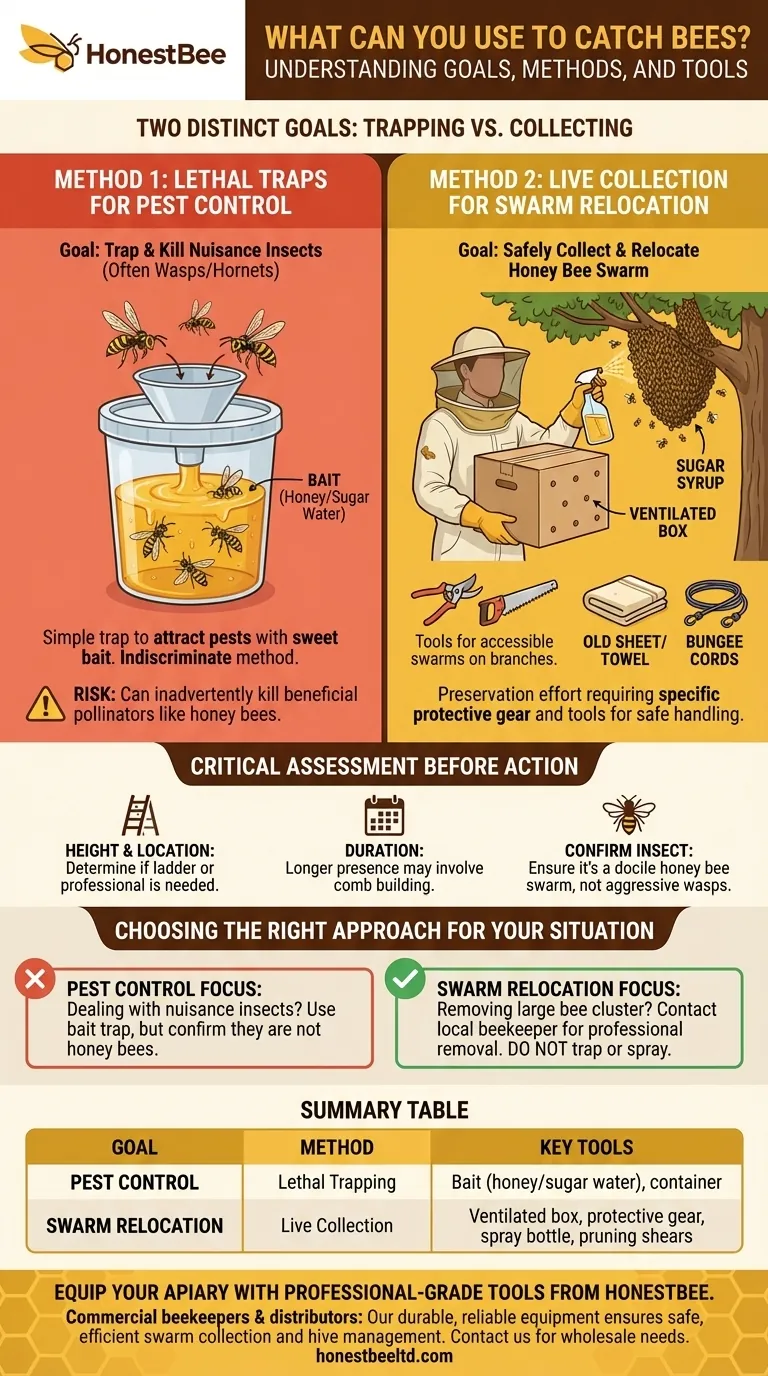The tools you use to catch bees depend entirely on whether your goal is to trap and kill a few nuisance insects or to safely collect and relocate an entire honey bee swarm. For simple pest control, a bait trap with honey or sugar water is used. For collecting a swarm, you need a specialized kit including a ventilated box, protective gear, and tools to handle the cluster.
The most critical first step is identifying your objective. The equipment for lethally trapping a single pest is fundamentally different—and incompatible with—the equipment needed for humanely collecting a valuable honey bee swarm.

Two Distinct Goals: Trapping vs. Collecting
The term "catching bees" can mean two very different things. Understanding the distinction is essential for safety, effectiveness, and environmental responsibility.
Method 1: Lethal Traps for Pest Control
This approach is designed to attract and kill individual insects that are considered pests, such as wasps or hornets, which are often mistaken for bees.
A simple trap can be made using sweet bait. Pour a thin layer of honey or sugar water into the bottom of a container. The sweetness attracts the insects, which fly in, become trapped in the liquid, and cannot escape.
Method 2: Live Collection for Swarm Relocation
This method is for capturing a large cluster of honey bees, known as a swarm, to move them to a new hive. This is a preservation effort, not extermination.
Successfully collecting a swarm requires a specific set of tools:
- A ventilated box, such as a cardboard box with air holes and a taped bottom.
- Protective clothing, especially a beekeeper's veil to protect your face.
- Pruning shears or a saw if the swarm is on a branch that can be safely cut.
- A spray bottle with sugar syrup to calm the bees and encourage them to cluster.
- An old sheet or towel to securely seal the box after the bees are inside.
- Bungee cords to keep the box sealed during transport.
Critical Pre-Capture Assessment for Swarms
Before attempting to collect a swarm, you must gather information to ensure a safe and successful operation. Rushing in without a plan is dangerous and often ineffective.
Key Questions to Ask
First, determine the height of the swarm to know if you need a ladder. Assess whether the bees are on a simple, cuttable branch or a more complex structure, like a wall, which may require a professional.
Finally, try to gauge how long the swarm has been there. A swarm that has been in place for several days may have started building a comb, making removal more complicated.
Confirming the Insect
It is crucial to confirm you are dealing with honey bees. Swarms are generally docile, as they have no hive to defend. Wasps, hornets, and yellowjackets are not honey bees, are far more aggressive, and should be handled with extreme caution, typically by pest control professionals.
Understanding the Trade-offs and Risks
Choosing the wrong method can have significant negative consequences. Using a lethal trap can inadvertently kill beneficial pollinators, while mishandling a swarm can be dangerous.
Risk of Harming Beneficial Pollinators
Lethal bait traps are indiscriminate. While you may be targeting wasps, you can easily attract and kill honey bees, which are vital for pollinating crops and local ecosystems. Killing a honey bee scout could even put a nearby hive at risk.
The Dangers of Inexperienced Swarm Capture
Attempting to capture a swarm without the proper equipment or knowledge is risky. You could be stung multiple times, fall from a ladder, or fail to capture the queen, causing the swarm to leave your box and settle somewhere else.
For these reasons, the best course of action for a swarm is almost always to contact a local beekeeping association. They have experienced members who will often remove the swarm for free.
Choosing the Right Approach for Your Situation
Your goal dictates your tools and methods. A clear understanding of your situation will lead you to the correct and safest solution.
- If your primary focus is dealing with a few nuisance insects near a patio: Consider using a simple bait trap, but first try to confirm they are not honey bees.
- If your primary focus is removing a large cluster of bees hanging from a tree or building: Do not attempt to trap or spray them; contact a local beekeeper or beekeeping association for safe, professional removal.
Ultimately, making an informed choice protects you, your community, and the essential role these insects play in our environment.
Summary Table:
| Goal | Method | Key Tools |
|---|---|---|
| Pest Control | Lethal Trapping | Bait (honey/sugar water), container |
| Swarm Relocation | Live Collection | Ventilated box, protective gear, spray bottle, pruning shears |
Equip your apiary with professional-grade tools from HONESTBEE. Whether you're a commercial beekeeper managing multiple hives or a distributor supplying the industry, our wholesale-focused operations provide the durable, reliable equipment you need for safe and efficient swarm collection and hive management. Contact our team today to discuss your specific needs and volume requirements.
Visual Guide

Related Products
- HONESTBEE Advanced Ergonomic Stainless Steel Hive Tool for Beekeeping
- Full Set Beekeeping Electronic Bee Venom Collector Machine Device for Bee Venom Collecting
- Professional Galvanized Hive Strap with Secure Locking Buckle for Beekeeping
- No Grafting Queen Rearing Kit: System for Royal Jelly Production and Queen Rearing
- Yellow Plastic Bucket Pail Perch for Beekeeping
People Also Ask
- What tools are used for cleaning frames? A Beekeeper's Simple 4-Tool Guide
- How is a hive tool used for scraping and cleaning? Master Hive Maintenance for a Healthy Colony
- What is a hive tool and what are its uses? Master Your Hive Inspections with the Essential Beekeeper's Tool
- Why is it important to compare the progress of different hives? A Beekeeper's Key Diagnostic Tool
- How should beekeepers handle bees when using a hive tool? Master Calm, Deliberate Techniques



















